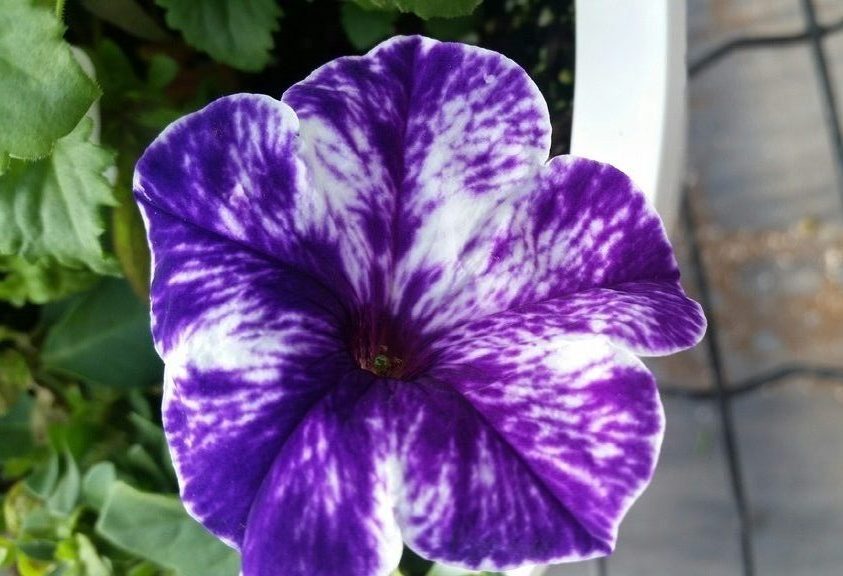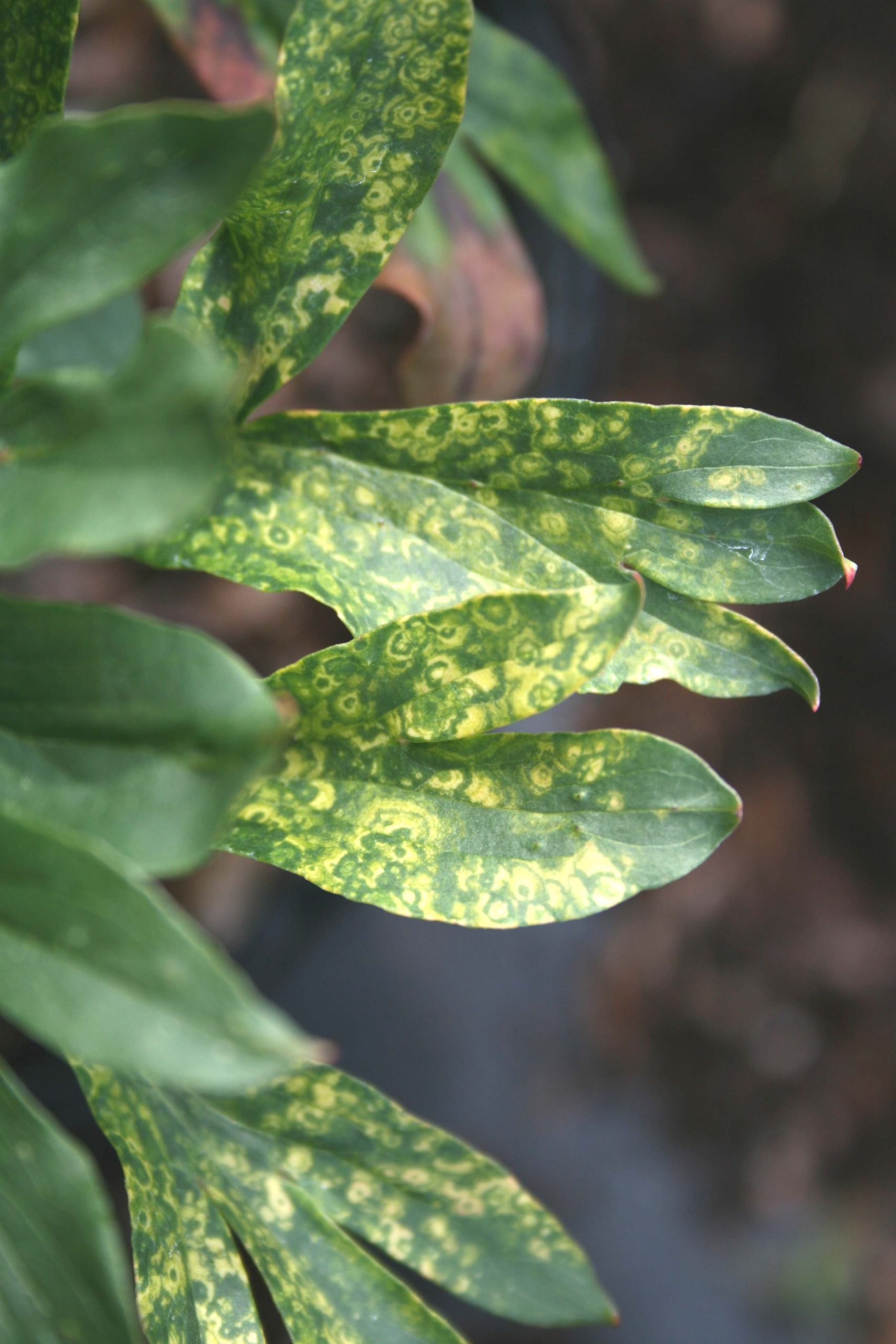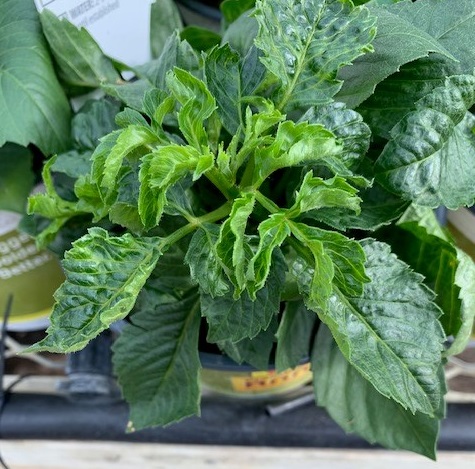During the hustle and bustle of the busy spring season, ornamental growers face various challenges as they work to ensure their crops remain vibrant, green, and free from pests and diseases. Among these challenges, viral infections are particularly feared—and with good reason, as there is no product that can “cure” a virus infected plant. As production areas become crowded, it is crucial to identify a virus at the first signs of trouble, since viruses spread easily and quickly.
Scouting & Insect Management
Scouting serves as the first line of defense against viral infections—not only for detecting the virus itself but also for identifying the insects that can transmit them. Thrips, for example, are notorious for transmitting viruses in the Tospovirus, Ilarvirus, Carmovirus, Sobemovirus, and Machlomovirus genera. Careful inspection of incoming plant material for signs of thrips damage and symptomatic plants should be isolated and treated as necessary. Using yellow or blue sticky cards (i.e., two per 1,000 square feet of production space including near doors or vents) in the greenhouse provides an effective way to monitor pest populations. Thrips can be detected through physical inspection, a “beat test”, or by recognizing their characteristic feeding damage. Damage from thrips often manifests as stippling, scarring, or white/silver discoloration on leaf surfaces, accompanied by tiny black spots that represent their frass. Some examples of proactive and reactive options to help manage thrips include rotations of Pylon (MOA 13), Overture (MOA UN), Avid (MOA 6) + Azatin O or Aza-Direct (MOA UN), M52 (MOA UNF), Pradia (MOA 28/29), and XXpire (MOA 4C/5). Preventative drench options include Kontos (MOA 23), Mainspring (MOA 28), and Mainspring Xtra (MOA 4A/28). Please reach out to GGSPro for comprehensive thrips control programs, rates, and additional plant safety considerations.
Becoming able to identify common virus symptoms while scouting is also valuable to isolate potentially infected material quickly. Infections can present a wide range of symptoms, but the most common include stunted growth, leaf and flower distortion, wilting, mottling, and discoloration or mosaic patterns on any above ground portion of the plant. Different viruses may cause different symptoms or express them under certain conditions (e.g., extreme heat, drought, or stress), so it’s important to remain vigilant.

Figure 1: Symptoms of Tobacco Mosaic Virus (TMV) on a Petunia flower.

Figure 2: Mosaic patterns on Peony.

Figure 3: Dahlia showing distorted growth, specific virus unknown.
Virus Testing
Testing is the only surefire way to confirm or rule out the presence of a virus. Depending on the situation, mail-in sampling may be necessary, or on-site test kits can be used for diagnostics through reputable laboratories, such as Agdia. Different plant species are susceptible to different viruses, so selecting the right test screening is important. Some viral symptoms can resemble nutritional disorders, so if tests return negative results, it’s worth closely examining the soil pH, EC, and tissue test results and modifying the feed program if necessary.
Since viruses have no cure, the only option is to dispose of symptomatic material. It is best practice to remove infected plants as soon as possible. Before disposing, it also prudent to document the issue by taking photos for potential future reference and aid in scouting efforts going forward. Ensure the use of proper personal protective equipment (PPE), such as plastic gloves and aprons, changing gloves as needed and disposing of them in bags containing the infected plants. This process should also include removing any adjacent plants, plastics, tags, soilless media, drippers, and making it the last task of the day to reduce the risk of spreading the virus to other areas. PPE should either be discarded or thoroughly washed, and areas containing symptomatic plants must be sanitized thoroughly.
Sanitation Procedures
For effective hard surface sanitation of tools and production spaces, quaternary ammonium products such as KleenGrow (an effective substitute for GreenShield II) or hydrogen peroxide/peracetic acid oxidizers SaniDate 5.0 and ZeroTol 2.0 are recommended. Other disinfectants, like a 10% bleach solution or 1% Virkon have also been used effectively. Since viruses can also spread through tools, hands, and direct plant-to-plant contact, maintaining a rigorous cleaning protocol is essential. For propagation scenarios, comprehensive procedures for changing gloves and disinfecting tools should be integrated throughout the sticking/planting line. If virus is detected, follow the simplified steps below for the best success:
In conclusion, proactively monitoring for virus symptoms and the pests that can vector viruses, confirming the presence of an infection through testing, and maintaining stringent sanitation practices are key to minimizing losses to viruses. By staying vigilant and implementing these practices consistently, growers can mitigate the risk of viral outbreaks and maintain a thriving, productive greenhouse throughout the busy spring season.
* Additional sizes are available
The information provided in this bulletin does not replace the need to read and follow the directions on entire product labels or supersede any applicable law, rule, regulation or standard. While every effort is made to ensure its accuracy, human error is possible, and labels do change without notice. Products other than those listed may be safe, legal and effective.
Note: Not all products are registered in all states. Some pesticides are restricted use in some states or regions and not others. It is the responsibility of the applicator to read and follow all label directions, remembering that labels may change. Other products may be safe and effective. Rates, application methods, and edible status are detailed in our GGSPro Insecticide & Fungicide Guides. Griffin also offers the 6th Edition GGSPro Technical Reference Guide. This valuable resource outlines a wide range of pest control options and information on pollinator safety, BCA’s, scouting, weed management, plant lighting, nutrition, water quality and more!
Scouting & Insect Management
Scouting serves as the first line of defense against viral infections—not only for detecting the virus itself but also for identifying the insects that can transmit them. Thrips, for example, are notorious for transmitting viruses in the Tospovirus, Ilarvirus, Carmovirus, Sobemovirus, and Machlomovirus genera. Careful inspection of incoming plant material for signs of thrips damage and symptomatic plants should be isolated and treated as necessary. Using yellow or blue sticky cards (i.e., two per 1,000 square feet of production space including near doors or vents) in the greenhouse provides an effective way to monitor pest populations. Thrips can be detected through physical inspection, a “beat test”, or by recognizing their characteristic feeding damage. Damage from thrips often manifests as stippling, scarring, or white/silver discoloration on leaf surfaces, accompanied by tiny black spots that represent their frass. Some examples of proactive and reactive options to help manage thrips include rotations of Pylon (MOA 13), Overture (MOA UN), Avid (MOA 6) + Azatin O or Aza-Direct (MOA UN), M52 (MOA UNF), Pradia (MOA 28/29), and XXpire (MOA 4C/5). Preventative drench options include Kontos (MOA 23), Mainspring (MOA 28), and Mainspring Xtra (MOA 4A/28). Please reach out to GGSPro for comprehensive thrips control programs, rates, and additional plant safety considerations.
Becoming able to identify common virus symptoms while scouting is also valuable to isolate potentially infected material quickly. Infections can present a wide range of symptoms, but the most common include stunted growth, leaf and flower distortion, wilting, mottling, and discoloration or mosaic patterns on any above ground portion of the plant. Different viruses may cause different symptoms or express them under certain conditions (e.g., extreme heat, drought, or stress), so it’s important to remain vigilant.

Figure 1: Symptoms of Tobacco Mosaic Virus (TMV) on a Petunia flower.

Figure 2: Mosaic patterns on Peony.

Figure 3: Dahlia showing distorted growth, specific virus unknown.
Virus Testing
Testing is the only surefire way to confirm or rule out the presence of a virus. Depending on the situation, mail-in sampling may be necessary, or on-site test kits can be used for diagnostics through reputable laboratories, such as Agdia. Different plant species are susceptible to different viruses, so selecting the right test screening is important. Some viral symptoms can resemble nutritional disorders, so if tests return negative results, it’s worth closely examining the soil pH, EC, and tissue test results and modifying the feed program if necessary.
Since viruses have no cure, the only option is to dispose of symptomatic material. It is best practice to remove infected plants as soon as possible. Before disposing, it also prudent to document the issue by taking photos for potential future reference and aid in scouting efforts going forward. Ensure the use of proper personal protective equipment (PPE), such as plastic gloves and aprons, changing gloves as needed and disposing of them in bags containing the infected plants. This process should also include removing any adjacent plants, plastics, tags, soilless media, drippers, and making it the last task of the day to reduce the risk of spreading the virus to other areas. PPE should either be discarded or thoroughly washed, and areas containing symptomatic plants must be sanitized thoroughly.
Sanitation Procedures
For effective hard surface sanitation of tools and production spaces, quaternary ammonium products such as KleenGrow (an effective substitute for GreenShield II) or hydrogen peroxide/peracetic acid oxidizers SaniDate 5.0 and ZeroTol 2.0 are recommended. Other disinfectants, like a 10% bleach solution or 1% Virkon have also been used effectively. Since viruses can also spread through tools, hands, and direct plant-to-plant contact, maintaining a rigorous cleaning protocol is essential. For propagation scenarios, comprehensive procedures for changing gloves and disinfecting tools should be integrated throughout the sticking/planting line. If virus is detected, follow the simplified steps below for the best success:
- Put on proper protective clothing including a lab coat, apron, and gloves. Gather garbage bags for plant material disposal and a disinfectant.
- Open the garbage bag by rolling the opening. Place infected plants, debris, and any other items or plants directly in contact with the plant (e.g., hanging basket hangers) into the garbage bag. If suspected or positively tested plants are in a liner tray, the entire tray should be disposed of accordingly. Similarly, if a combination planter contains one plant that is suspected of virus or positively tested, the entire planters should be disposed of.
- Clean the affected area with Strip-It PRO at 5oz per gallon. Rinse this solution prior to drying. Then, disinfect the surrounding area with a SaniDate 5.0, ZeroTol 2.0, KleenGrow, 1% Virkon, or a 10% bleach solution. These cleaners and disinfectant solutions should not be applied directly to plant material or damage will occur.
- When everything is removed and disinfected, take off protective clothing and gloves at the spot where disinfection occurred, and place them in garbage bag. Close the garbage bags at the spot of disinfection. Do not walk with the infected material unless it is properly enclosed in a garbage bag. Prevent cross contamination by not allowing the garbage to touch neighboring plant material.
- Remove the garbage bag(s) immediately from the greenhouse. Disinfect any used tools and wash hands thoroughly afterwards. Dispose materials off-site or where re-contamination is not possible.
In conclusion, proactively monitoring for virus symptoms and the pests that can vector viruses, confirming the presence of an infection through testing, and maintaining stringent sanitation practices are key to minimizing losses to viruses. By staying vigilant and implementing these practices consistently, growers can mitigate the risk of viral outbreaks and maintain a thriving, productive greenhouse throughout the busy spring season.
| Product | Item Number | Product Size |
|---|---|---|
| SaniDate 5.0* | 71-35001 | 2.5 gal |
| ZeroTol 2.0* | 71-35501 | 2.5 gal |
| KleenGrow* | 74-21125 | 2.5 gal |
| Yellow Sticky Cards* | SB8051-03 | Yellow 20 Cards/Pack |
| Pylon* | 70-2675> | 1 pt |
| Overture | 70-2590 | 1 lb |
| Avid* | 70-1185 | 1 qt |
| Azatin O | 70-12301 | 1 qt |
| Aza-Direct | 70-1222 | 2.5 gal |
| Kontos | 70-19601 | 250 ml |
| Mainspring* | 70-2331 | 1 pt |
The information provided in this bulletin does not replace the need to read and follow the directions on entire product labels or supersede any applicable law, rule, regulation or standard. While every effort is made to ensure its accuracy, human error is possible, and labels do change without notice. Products other than those listed may be safe, legal and effective.
Note: Not all products are registered in all states. Some pesticides are restricted use in some states or regions and not others. It is the responsibility of the applicator to read and follow all label directions, remembering that labels may change. Other products may be safe and effective. Rates, application methods, and edible status are detailed in our GGSPro Insecticide & Fungicide Guides. Griffin also offers the 6th Edition GGSPro Technical Reference Guide. This valuable resource outlines a wide range of pest control options and information on pollinator safety, BCA’s, scouting, weed management, plant lighting, nutrition, water quality and more!